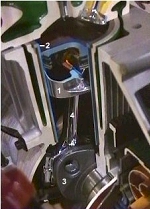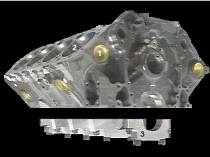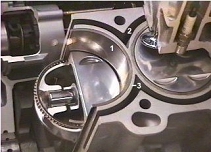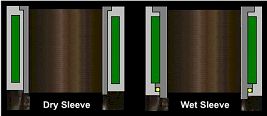The Engine Block
Note: This content is directly from our Road Machines Educational CD, available for purchase and download instantly in our store.
General:
 The engine's bottom end is where all the work is done. Expanding combustion gases apply pressure to the pistons, forcing them downward, which results in crankshaft rotation. The cylinder block is the main bottom end structure. Pistons (1) ride up and down in cylinder sleeves (2) that are fitted in the cylinder bores. The pistons are attached to the crankshaft (3) by connecting rods (4).
The engine's bottom end is where all the work is done. Expanding combustion gases apply pressure to the pistons, forcing them downward, which results in crankshaft rotation. The cylinder block is the main bottom end structure. Pistons (1) ride up and down in cylinder sleeves (2) that are fitted in the cylinder bores. The pistons are attached to the crankshaft (3) by connecting rods (4).

Cylinder Block:
The cylinder block, also called engine block, is the main bottom end structure. Iron or aluminum is normally used for its construction. Nickel may be added to the iron to increase strength and wear. Aluminum blocks weigh less and are better at dissipating heat. Core plugs (1), also called freeze plugs, seal holes left in the block after casting. The plugs prevent the leakage of coolant from the water jackets.
Block Design:
The design of the cylinder block varies among manufacturers. The block's geometry is determined by the number of cylinders (2), cylinder orientation (opposed, in-line, slant, V-shaped), and camshaft location (overhead cam or in-block cam). Regardless of design, the block must withstand the forces exerted by the pistons and crankshaft, serve as a mounting structure for other engine components, and be light in weight.
Main Caps:
The main caps (3) secure the crankshaft to the engine block. When bolted in place, they form the main bearing bore in which the crankshaft's main journals rotate. Two or four bolts are used to secure the caps. Some blocks use a main cap girdle which is a structure in which the caps rest. The caps and girdle are secured to the block.

Cylinder Sleeves:
Cylinder sleeves (1) or liners are removable, cylindrical inserts. Two types are used. The dry sleeve is separated from the water jacket (2) by the cylinder wall (3). The wet sleeve is in direct contact with the coolant and has thicker walls since no outside structure provides support. Sleeves are typically cast iron.

Dry Sleeves:
Dry sleeves are thinner in construction since structural support is provided by the engine block cylinder wall. The loads generated by combustion pressure are absorbed by the engine block and not the sleeve. Dry sleeves can be pressed into older engines to repair damaged cylinders.
Wet Sleeves:
Wet sleeves are designed to withstand the loads generated by combustion pressure. The sleeves are in direct contact with engine coolant. A rubber or copper O-ring (yellow circle) is used at the bottom flange to prevent coolant from leaking into the crankcase. The cylinder head gasket prevents any coolant leaking through the top.


